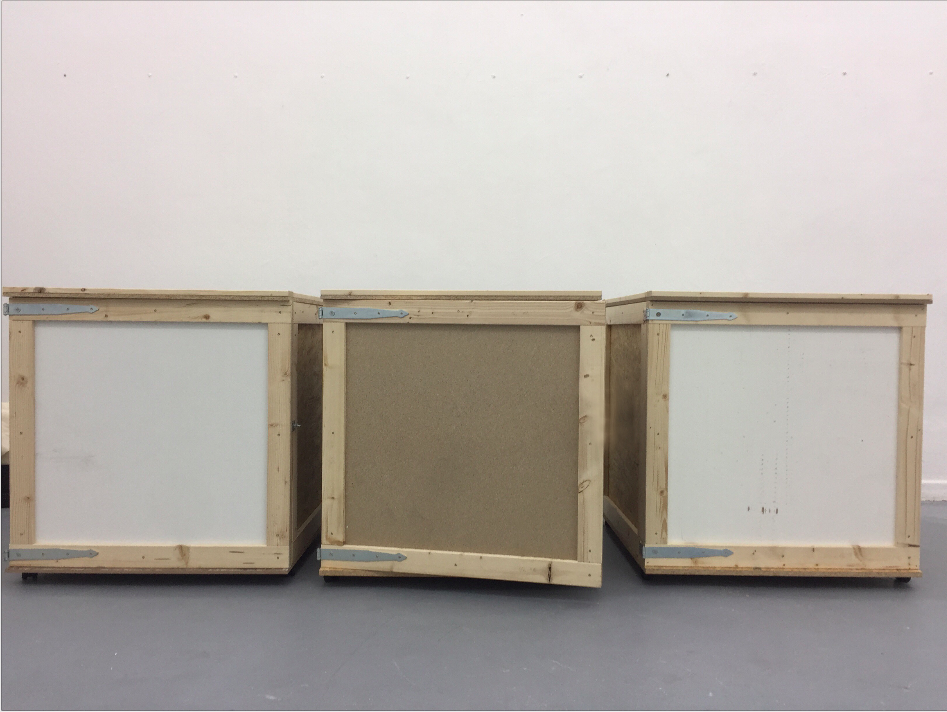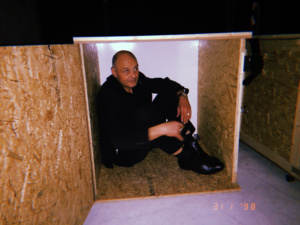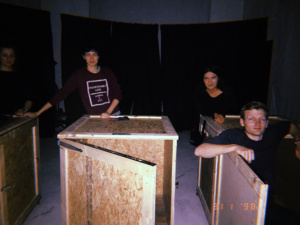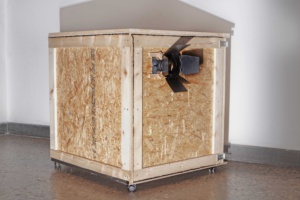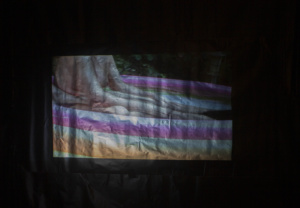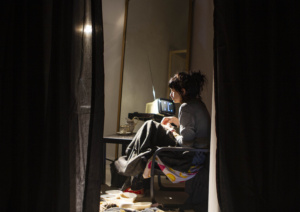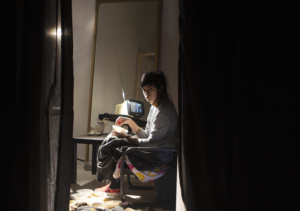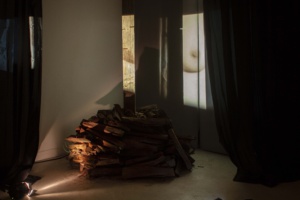Emphatic Apparatus I
10 min every 20 min over 9 hours per day
31-01 and 04-02-2018
Kunstakademie Rundgang 2018, Room 121
Düsseldorf, Germany
Emphatic Apparatus I is an immersive performative installation that takes the visitors on a tour of different points of view of exclusion, from familial, to historical, to a modern society where people eventually find themselves excluded as a result of the lack of empathy of others.
By putting the visitors in boxes and locking them there they are experiencing another layer of seclusion and separation from the room they are being moved through, other members of the audience, and also from the works of art.
Detailed Description:
The room where this immersive performative installation is happening is completely dark. Blacked out. The visitors come in in groups of 3. Each of the people in the group of 3 gets put in a crate box. Each box has a peephole with a shutter. The boxes have wheels and are pushed around the room. They get stopped 3 times in the room in different stations. When they are in position, the peepholes have their shutters open and the lights of the station is turned on, so that each person inside can see what is happening.
After a limited amount of time spent at each station, the stutter is closed, the lights turned off and they are pushed to the next station.
After the whole tour, the stutters are closed, the lights go off and curtains are being pulled surrounding each station, so that when the visitors are released from the boxes, they are not able to perceive how big the room is or how the different stations look like from outside of the box.
Station 1 – Everyday with you feels like kindergarten.
A movie projection of two adults in a children’s’ pool. One cannot see faces and the relationship and interaction in this movie is unclear. Yet this starting point is meant to place the visitor in an intimate and personal position, one of reminiscent childhood be it their own or just the idea of a childhood.
Station 2 – The historical social exclusion
A video installation this time, where the idea of out casting and excluding people was elevated to such a level that it has became a symbol for somebody that does not fit in. The symbol of the witch is being used, in a culminant situation, that of the burning on the stake. A real life size stake with all the wood necessary for burning has been set up. A mapped video projection is displaying a body of a woman being pricked with a needle and reacting to it.
Station 3 – Coming back to modern times
This last station is a performative installation. A part of a living room is reproduced as a set for the installation. The point of view is from the hallway into the living room. A TV can be seen with a mixed loop composed of the first video game (Ping-Pong) and a recording of a gabber party. The performer sits on a chair in front of the TV, eating. She paying attention to the ping-pong video game and every time the gabber party comes on, she starts imitating the dance in the chair. In the beginning she ignores the visitors looking at her from the boxes, but at a given point she makes eye contact, drops her food bowl and covers herself with a blanket, thus excluding herself from any interaction.
Idea:
Does one really know what empathy is, and how and when we need it. How differently we live exclusion and being pushed aside in so many forms that it becomes absurd.
We are connected, in theory, yet still, we cannot create, usually, a sincere connection, forgetting that the only nature that is the most difficult to take away from us (to be robbed of) is, the other [human]. We do not perceive the individuals as a human anymore, but as a fact, an object or a pseudo-medical situation. Regardless of the time and space, the empathy is somehow, lost.
The importance of this Apparatus, a performative, immersive installation stands in the coming into existence of situations that are experienced by the participants in a confined, limitative space.
Each person experiencing this performative installation is alone, with his/her own thoughts, detached from the situation that they are observing, yet at the same time extremely close.
Every situation to be experienced has in its meanings a variety of possible understandings being able to be interpreted differently by each individual.
The Emphatic Apparatus is an endurance performance lasting for approximately 10 hours, grasping grave reality of the moments presented. The participants only catch a glimpse of the whole performance, through a peep-hole, as a metaphor of the day-to-day circumstances of isolation, exclusion and awkwardness. As an allusion to the fact that, after finding about a somber matter one will not usually observe it too much, or take action towards it and one is usually in the comfort of one’s own little box.
The participants are out of time and space and they are being exposed to intense emotions coming from their exterior as well as from their interior.
THOUGHT STREAM:
empathy
[em-puh-thee]
Synonyms:
Affinity, appreciation, insight, pity, warmth, communion, comprehension, responsiveness, being on the same wavelength, being there for someone, community of interests, cottoning to, good vibrations.
Examples:
Word Origin
noun
- The psychological identification with or vicarious experiencing of the feelings, thoughts, or attitudes of another.
2. The imaginative ascribing to an object, as a natural object or work of art, feelings or attitudes present in oneself:
By means of empathy, a great painting becomes a mirror of the self.
Origin of empathy:
Greek
1900-1905
Greek empátheia affection, equivalent to em- em-2+ path-(base of páschein to suffer) + -eia -ia; present meaning translates German Einfühlung
Can be confused
Empathy – sympathy
“Never has the world seemed so completely united – in the form of communication, commerce, and culture; and so savagely torn apart-in the form of war, financial meltdown, global warming, and even the migration of diseases”. The Emphatic Civilisations, Jeremy Rifkin
The more we are connected, side by side, yet still, we cannot create, usually, a sincere connection, forgetting that the only nature that is the most difficult to take away from us (to be robbed of) is, the other [human], the less we realise our ridiculousness when we are only projecting ourselves unilaterally, onto the others. We have left behind the initial idea of belonging, or projection for that matter and we have brought ourselves together, by tearing ourselves apart in the goo of superficiality.
We handle ourselves in defences with what we have on hand, becoming irrational, too emotional when it is not needed and cold as the vacuum of plastic, because in this case even stones react in breaking and showing the same shimmery inside, portraying a feeling, when, we should, show a soft emotion.
We came to a point [repetition] in which we interact with the appearances and not with the realness.
Links:

